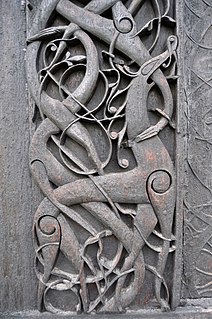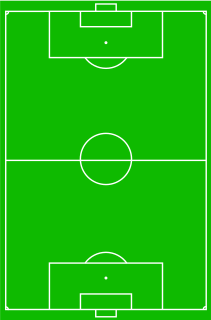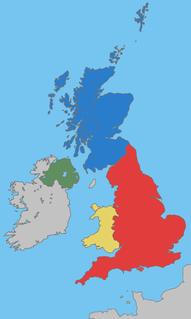Related Research Articles

Feudalism, also known as the feudal system, was a combination of the legal, economic, military, and cultural customs that flourished in Medieval Europe between the 9th and 15th centuries. Broadly defined, it was a way of structuring society around relationships that were derived from the holding of land in exchange for service or labor. Although it is derived from the Latin word feodum or feudum (fief), which was used during the Medieval period, the term feudalism and the system which it describes were not conceived of as a formal political system by the people who lived during the Middle Ages. The classic definition, by François-Louis Ganshof (1944), describes a set of reciprocal legal and military obligations which existed among the warrior nobility and revolved around the three key concepts of lords, vassals and fiefs.

A regular expression is a sequence of characters that define a search pattern. Usually such patterns are used by string-searching algorithms for "find" or "find and replace" operations on strings, or for input validation. It is a technique developed in theoretical computer science and formal language theory.

In Norse mythology, Ragnarök is a series of events, including a great battle, foretold to lead to the death of a number of great figures, natural disasters and the submersion of the world in water. After these events, the world will resurface anew and fertile, the surviving and returning gods will meet and the world will be repopulated by two human survivors. Ragnarök is an important event in Norse mythology and has been the subject of scholarly discourse and theory in the history of Germanic studies.

Satan, also known as the Devil, is an entity in the Abrahamic religions that seduces humans into sin or falsehood. In Christianity and Islam, he is usually seen as either a fallen angel or a genie, who used to possess great piety and beauty, but rebelled against God, who nevertheless allows him temporary power over the fallen world and a host of demons. In Judaism, Satan is typically regarded as a metaphor for the yetzer hara, or "evil inclination", or as an agent subservient to God.

In physics, string theory is a theoretical framework in which the point-like particles of particle physics are replaced by one-dimensional objects called strings. String theory describes how these strings propagate through space and interact with each other. On distance scales larger than the string scale, a string looks just like an ordinary particle, with its mass, charge, and other properties determined by the vibrational state of the string. In string theory, one of the many vibrational states of the string corresponds to the graviton, a quantum mechanical particle that carries gravitational force. Thus string theory is a theory of quantum gravity.

A troll is a being in Scandinavian folklore, including Norse mythology. In Old Norse sources, beings described as trolls dwell in isolated rocks, mountains, or caves, live together in small family units, and are rarely helpful to human beings.

Ursula Kroeber Le Guin was an American author best known for her works of speculative fiction, including science fiction works set in her Hainish universe, and the Earthsea fantasy series. She was first published in 1959, and her literary career spanned nearly sixty years, yielding more than twenty novels and over a hundred short stories, in addition to poetry, literary criticism, translations, and children's books. Frequently described as an author of science fiction, Le Guin has also been called a "major voice in American Letters." Le Guin herself said she would prefer to be known as an "American novelist".

In Norse mythology, Valhalla is a majestic, enormous hall located in Asgard, ruled over by the god Odin. Chosen by Odin, half of those who die in combat travel to Valhalla upon death, led by valkyries, while the other half go to the goddess Freyja's field Fólkvangr. In Valhalla, the dead warriors join the masses of those who have died in combat and various legendary Germanic heroes and kings, as they prepare to aid Odin during the events of Ragnarök. Before the hall stands the golden tree Glasir, and the hall's ceiling is thatched with golden shields. Various creatures live around Valhalla, such as the stag Eikþyrnir and the goat Heiðrún, both described as standing atop Valhalla and consuming the foliage of the tree Læraðr.

Yggdrasil, in Norse cosmology, is an immense and central sacred tree. Around it exists all else, including the Nine Worlds.

Gravity, or gravitation, is a natural phenomenon by which all things with mass or energy—including planets, stars, galaxies, and even light—are brought toward one another. On Earth, gravity gives weight to physical objects, and the Moon's gravity causes the ocean tides. The gravitational attraction of the original gaseous matter present in the Universe caused it to begin coalescing and forming stars and caused the stars to group together into galaxies, so gravity is responsible for many of the large-scale structures in the Universe. Gravity has an infinite range, although its effects become increasingly weaker as objects get further away.

Standard anatomical terms of location deal unambiguously with the anatomy of animals, including humans. Terms used generally derive from Latin or Greek roots and used to describe something in its standard anatomical position. This position provides a definition of what is at the front ("anterior"), behind ("posterior") and so on. As part of defining and describing terms, the body is described through the use of anatomical planes and anatomical axes.

A midfielder is an association football position. Midfielders are generally positioned on the field between their team's defenders and forwards. Some midfielders play a disciplined defensive role, breaking up attacks, and are otherwise known as defensive midfielders. Others blur the boundaries, being more mobile and efficient in passing: they are commonly referred to as deep-lying midfielders, play-makers, box-to-box, or holding midfielders. The number of midfielders on a team and their assigned roles depends on the team's formation; the collective group of these players on the field is sometimes referred to as the midfield.

Dark fantasy is a subgenre of fantasy literary, artistic, and cinematic works that incorporate darker and frightening themes of fantasy. It often combines fantasy with elements of horror or has a gloomy dark tone or a sense of horror and dread.

Saif Ali Khan is an Indian actor and producer who works in Hindi films. The son of actress Sharmila Tagore and cricketer Mansoor Ali Khan Pataudi, Khan made his acting debut in Yash Chopra's drama Parampara (1993), but achieved success with his roles in the romantic drama Yeh Dillagi and the action film Main Khiladi Tu Anari. Khan's career prospect declined through much of the 1990s, and his biggest commercial success of the decade came with the ensemble drama Hum Saath-Saath Hain (1999). He rose to prominence with roles in two ensemble comedy-dramas—Dil Chahta Hai (2001) and Kal Ho Naa Ho (2003).
Gaslighting is a form of psychological manipulation in which a person or a group covertly sows seeds of doubt in a targeted individual or group, making them question their own memory, perception, or judgement. It may evoke changes in them such as cognitive dissonance or low self-esteem, rendering the victim additionally dependent on the gaslighter for emotional support and validation. Using denial, misdirection, contradiction, and misinformation, gaslighting involves attempts to destabilize the victim and delegitimize the victim's beliefs.

Motion, the process of movement, is described using specific anatomical terms. Motion includes movement of organs, joints, limbs, and specific sections of the body. The terminology used describes this motion according to its direction relative to the anatomical position of the joints. Anatomists use a unified set of terms to describe most of the movements, although other, more specialized terms are necessary for describing the uniqueness of the movements such as those of the hands, feet, and eyes.
Gay is a term that primarily refers to a homosexual person or the trait of being homosexual. The term was originally used to mean "carefree", "cheerful", or "bright and showy".

Parler is an American microblogging and social networking service. Parler has a significant user base of Donald Trump supporters, conservatives, conspiracy theorists, and right-wing extremists. Posts on the service often contain far-right content, antisemitism, and conspiracy theories such as QAnon. Journalists have described Parler as an alternative to Twitter, and users include those banned from mainstream social networks or opposing their moderation policies.

The United Kingdom of Great Britain and Northern Ireland (UK), since 1922, comprises four constituent countries: England, Scotland, and Wales, as well as Northern Ireland. The UK Prime Minister's website has used the phrase "countries within a country" to describe the United Kingdom. Some statistical summaries, such as those for the twelve NUTS 1 regions of the United Kingdom refer to Scotland, Wales and Northern Ireland as "regions". With regard to Northern Ireland and Scotland particularly, the descriptive name used "can be controversial, with the choice often revealing one's political preferences".

Metadata is "data that provides information about other data". In other words, it is "data about data". Many distinct types of metadata exist, including descriptive metadata, structural metadata, administrative metadata, reference metadata and statistical metadata.
References
- ↑ "GlobIZ search". Global Information System on Pyraloidea. Retrieved June 3, 2017.
| | This Epipaschiinae-related article is a stub. You can help Wikipedia by expanding it. |